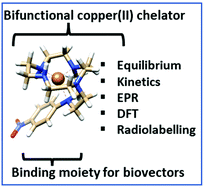Exceptionally fast formation of stable rigidified cross-bridged complexes formed with Cu(ii) isotopes for molecular imaging†
Abstract
64Cu is considered to be one of the most promising radioisotopes in radiotheranostics (combining therapeutics with diagnostics) because its positron emission is suitable for PET imaging while the combination of its β− and Auger electrons delivers a therapeutic effect. In this work, we present a thorough coordination chemical characterization of two Cu(II) complexes formed from the cross-bridged pentaazamacrocyclic CB-15aneN5 and its bifunctional derivative. The Cu(II) chelates possess high thermodynamic stability, fast complexation and moderate inertness under harsh conditions (t1/2 = 2.3 h, 5 M HCl, 50 °C). EPR measurements and DFT calculations were carried out for characterizing their structure in solution. Furthermore, the radiolabeling experiments performed with 61Cu(II) confirmed the fast complexation even in the μM concentration range at pH = 6.0. On the basis of these results, the CB-15aneN5 ligand family serves as an excellent platform for Cu(II) complexation in radiotheranostics.

- This article is part of the themed collection: FOCUS: Recent progress on bioimaging technologies


 Please wait while we load your content...
Please wait while we load your content...